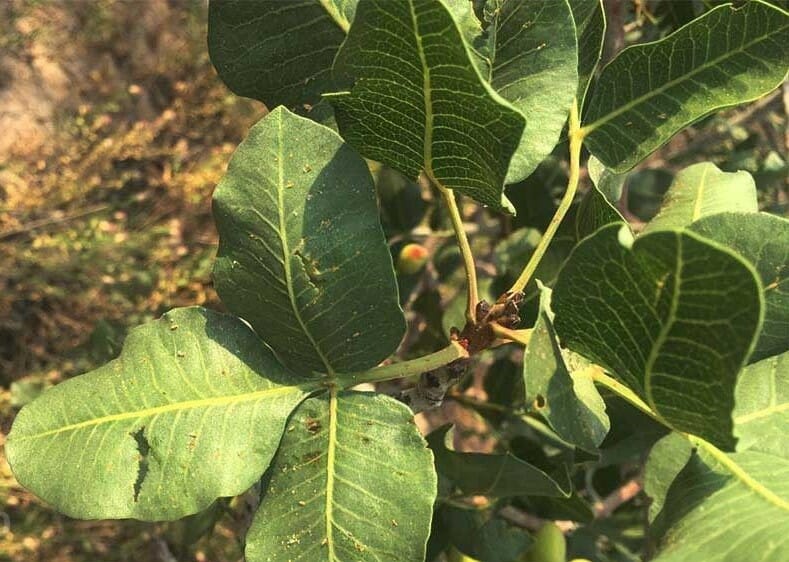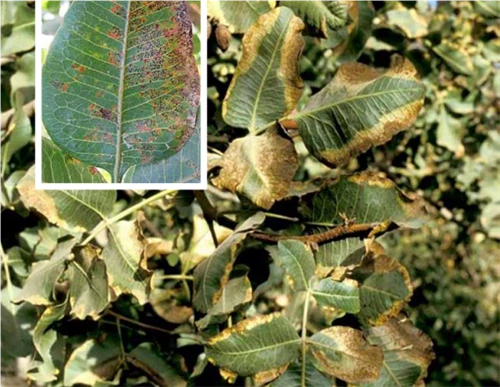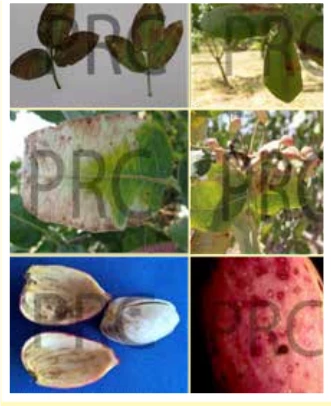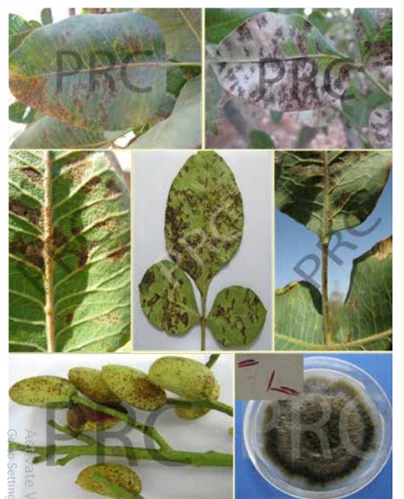
Late Alternaria Blight This disease, also known as Alternaria leaf spot, is observed in regions with humid climates, high rainfall, dense orchards, flood and heavy irrigation, or abundant weeds. Severe infection in pistachio orchards reduces the quantity and quality of pistachio nuts.
Symptoms of the Disease
Usually, leaf infections occur in spring, and the progression of the disease stops in summer, except in areas with summer rainfall. The spots on the leaves are circular to irregular, and as the disease progresses, they merge and may cover the entire leaf blade, which reduces photosynthesis in pistachio trees. Darkening of the central part of the spots in humid conditions is due to the production of dark conidia of the pathogen. Severe and premature leaf drop as the infection spreads on the leaf blade, the formation of small dark spots with a diameter of about 1 mm on unripe nuts, the enlargement of the spots on ripe nuts surrounded by a reddish-purple halo, and the spread of spots into the inner tissue of the green skin and the formation of blemishes on the woody shell of pistachio nuts are other signs of Alternaria leaf spot infection. In some regions, mold growth on the kernel has also been reported. This disease is more severe in high-yield years compared to low-yield years; therefore, leaves near clusters or older leaves are more sensitive. Alternaria species can infect buds without showing any symptoms.

Disease Control
Controlling Alternaria leaf spot requires a combination of agricultural practices (irrigation management, pruning to increase airflow and reduce humidity in orchards, and weed control in orchards) and several applications of fungicides. Although a wide range of fungicides is used to control Alternaria leaf spot in other countries, no fungicide has yet been registered in Iran for this disease; however, preliminary studies are underway to evaluate and introduce a fungicide.
Although multiple fungicide applications are one of the main strategies to reduce the damage of Alternaria leaf spot, the different reactions of various Alternaria species, their rapid resistance development, and pesticide residues in pistachios are important considerations when recommending fungicides for chemical control of this disease. Currently, provided the disease is correctly diagnosed in areas with high levels of leaf and fruit infection, the use of sulfur or copper compounds can reduce disease symptoms and its damage; however, weather conditions, growth stages, and the sensitivity of pistachio trees must be considered. If chemical control of the disease is necessary, fungicides should be used that both have a lower potential to create resistance among Alternaria species and do not limit the residues in the produced pistachio crop.
Some strategies that are effective in reducing the damage of Alternaria leaf spot include:
- Shortening irrigation periods in late spring and early summer;
- Irrigating orchards in a way that the soil surface dries quickly;
- Proper pruning of trees;
- Weed control, which can lead to increased airflow and reduced humidity in pistachio orchards;
- Timely harvesting of pistachios to minimize fruit infection and blemishes on the woody shell.
Septoria Leaf Spot
The emergence and severity of this disease are high in pistachio orchards in humid regions. In severe epidemics, tree infections can cause leaf drop and tree weakening.
Symptoms of the Disease
At the beginning of the season, especially after spring rains, greenish-yellow spots form on both sides of the leaves, which merge and turn brown as the disease progresses. Simultaneously, pycnidia, the fruiting bodies of the pathogen, appear as black dots within the spots. Spots accompanied by the pycnidia of the pathogen are also observed on the main vein, petioles, and fruit stalks. In pistachio orchards in California, with the activity of the pathogen on fruits, gray to light brown spots form surrounded by a bright red halo; however, in Iran, symptoms on fruits appear as small brown spots that spread under humid conditions. Rain or humidity caused by sprinkler irrigation spreads fungal conidia and causes secondary infections that may continue to appear until mid-autumn.

Disease Control
In areas with severe infection, the use of appropriate fungicides is recommended as soon as the first symptoms of the disease appear on the leaves, and if necessary, monthly sprays should be continued. Although fungicides are registered for controlling Septoria leaf spot in wheat, no fungicide has been introduced for controlling this disease on pistachio trees so far. In highly infected orchards, after consulting expert specialists and ensuring the absence of fungicide residues, under controlled conditions, some approved fungicides for controlling Septoria leaf spot in wheat may also be used for pistachio trees. If necessary, protective fungicides such as dithiocarbamates and copper compounds can only be used when the fruit size has reached 1 cm or more to prevent phytotoxicity.
Avoiding frequent, heavy irrigation during the growing season can also help reduce the severity of the disease in pistachio orchards. Pruning trees and maintaining planting distances to improve ventilation and controlling weeds to reduce orchard humidity are also effective in reducing disease damage.